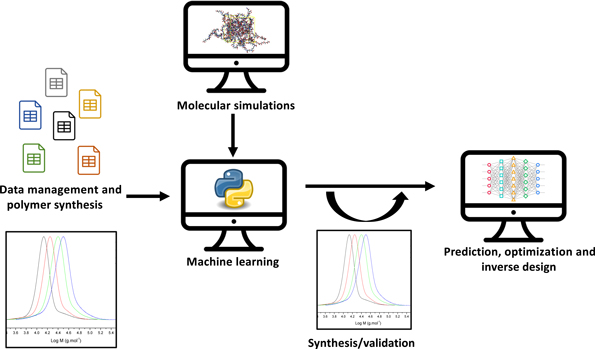Crossref Citations
This article has been cited by the following publications. This list is generated based on data provided by Crossref.
Chen, Guang
Shen, Zhiqiang
Iyer, Akshay
Ghumman, Umar Farooq
Tang, Shan
Bi, Jinbo
Chen, Wei
and
Li, Ying
2020.
Machine-Learning-Assisted De Novo Design of Organic Molecules and Polymers: Opportunities and Challenges.
Polymers,
Vol. 12,
Issue. 1,
p.
163.
Schuett, Timo
Kimmig, Julian
Zechel, Stefan
and
Schubert, Ulrich S.
2020.
Automated Polymer Purification Using Dialysis.
Polymers,
Vol. 12,
Issue. 9,
p.
2095.
Park, Nathaniel H.
Zubarev, Dmitry Yu.
Hedrick, James L.
Kiyek, Vivien
Corbet, Christiaan
and
Lottier, Simon
2020.
A Recommender System for Inverse Design of Polycarbonates and Polyesters.
Macromolecules,
Vol. 53,
Issue. 24,
p.
10847.
Rizkin, Benjamin A.
and
Hartman, Ryan L.
2020.
Activation of homogenous polyolefin catalysis with a machine-assisted reactor laboratory-in-a-box (μAIR-LAB).
Reaction Chemistry & Engineering,
Vol. 5,
Issue. 8,
p.
1450.
Hedden, Ronald C
2020.
High-throughput screening of polymeric membranes for liquid mixture separation.
Current Opinion in Chemical Engineering,
Vol. 28,
Issue. ,
p.
83.
Knox, Stephen T.
and
Warren, Nicholas J.
2020.
Enabling technologies in polymer synthesis: accessing a new design space for advanced polymer materials.
Reaction Chemistry & Engineering,
Vol. 5,
Issue. 3,
p.
405.
Selvaratnam, Balaranjan
and
Koodali, Ranjit T.
2021.
Machine learning in experimental materials chemistry.
Catalysis Today,
Vol. 371,
Issue. ,
p.
77.
Tan, Yu Jun
Susanto, Glenys Jocelin
Anwar Ali, Hashina Parveen
and
Tee, Benjamin C. K.
2021.
Progress and Roadmap for Intelligent Self‐Healing Materials in Autonomous Robotics.
Advanced Materials,
Vol. 33,
Issue. 19,
Hagita, Katsumi
Aoyagi, Takeshi
Abe, Yuto
Genda, Shinya
and
Honda, Takashi
2021.
Deep learning-based estimation of Flory–Huggins parameter of A–B block copolymers from cross-sectional images of phase-separated structures.
Scientific Reports,
Vol. 11,
Issue. 1,
Kimmig, Julian
Zechel, Stefan
and
Schubert, Ulrich S.
2021.
Digital Transformation in Materials Science: A Paradigm Change in Material's Development.
Advanced Materials,
Vol. 33,
Issue. 8,
Tammaro, Daniele
D'Avino, Gaetano
Costanzo, Salvatore
Di Maio, Ernesto
Grizzuti, Nino
and
Maffettone, Pier Luca
2021.
A microcapillary rheometer for microliter sized polymer characterization.
Polymer Testing,
Vol. 102,
Issue. ,
p.
107332.
Luengo, Gustavo S.
Fameau, Anne-Laure
Léonforte, Fabien
and
Greaves, Andrew J.
2021.
Surface science of cosmetic substrates, cleansing actives and formulations.
Advances in Colloid and Interface Science,
Vol. 290,
Issue. ,
p.
102383.
Chowdhury, Mohammad Asaduzzaman
Hossain, Nayem
Ahmed Shuvho, Md Bengir
Fotouhi, Mohammad
Islam, Md Sakibul
Ali, Md Ramjan
and
Kashem, Mohammod Abul
2021.
Recent machine learning guided material research - A review.
Computational Condensed Matter,
Vol. 29,
Issue. ,
p.
e00597.
Kumar, Ramya
2022.
Materiomically Designed Polymeric Vehicles for Nucleic Acids: Quo Vadis?.
ACS Applied Bio Materials,
Vol. 5,
Issue. 6,
p.
2507.
Ho, Nang Xuan
Le, Tien-Thinh
and
Le, Minh Vuong
2022.
Development of artificial intelligence based model for the prediction of Young’s modulus of polymer/carbon-nanotubes composites.
Mechanics of Advanced Materials and Structures,
Vol. 29,
Issue. 27,
p.
5965.
Heiranian, Mohammad
DuChanois, Ryan M.
Ritt, Cody L.
Violet, Camille
and
Elimelech, Menachem
2022.
Molecular Simulations to Elucidate Transport Phenomena in Polymeric Membranes.
Environmental Science & Technology,
Vol. 56,
Issue. 6,
p.
3313.
Champa-Bujaico, Elizabeth
García-Díaz, Pilar
and
Díez-Pascual, Ana M.
2022.
Machine Learning for Property Prediction and Optimization of Polymeric Nanocomposites: A State-of-the-Art.
International Journal of Molecular Sciences,
Vol. 23,
Issue. 18,
p.
10712.
Zou, Weizhong
Martell Monterroza, Alexis
Yao, Yunxin
Millik, S. Cem
Cencer, Morgan M.
Rebello, Nathan J.
Beech, Haley K.
Morris, Melody A.
Lin, Tzyy-Shyang
Castano, Cleotilde S.
Kalow, Julia A.
Craig, Stephen L.
Nelson, Alshakim
Moore, Jeffrey S.
and
Olsen, Bradley D.
2022.
Extending BigSMILES to non-covalent bonds in supramolecular polymer assemblies.
Chemical Science,
Vol. 13,
Issue. 41,
p.
12045.
Goodarzi, Babak Valipour
and
Bahramian, Ahmad Reza
2022.
Applying machine learning for predicting thermal conductivity coefficient of polymeric aerogels.
Journal of Thermal Analysis and Calorimetry,
Vol. 147,
Issue. 11,
p.
6227.
Zhu, Ming‐Xiao
Deng, Ting
Dong, Lei
Chen, Ji‐Ming
and
Dang, Zhi‐Min
2022.
Review of machine learning‐driven design of polymer‐based dielectrics.
IET Nanodielectrics,
Vol. 5,
Issue. 1,
p.
24.


